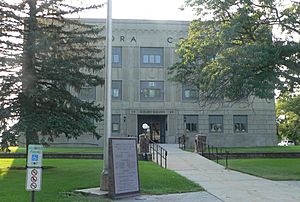Plankinton, South Dakota facts for kids
Quick facts for kids
Plankinton, South Dakota
|
|
|---|---|

Aurora County Courthouse
|
|

Location in Aurora County and the state of South Dakota
|
|
| Country | United States |
| State | South Dakota |
| County | Aurora |
| Incorporated | 1887 |
| Area | |
| • Total | 0.76 sq mi (1.98 km2) |
| • Land | 0.76 sq mi (1.98 km2) |
| • Water | 0.00 sq mi (0.00 km2) |
| Elevation | 1,519 ft (463 m) |
| Population
(2020)
|
|
| • Total | 781 |
| • Density | 1,023.59/sq mi (395.03/km2) |
| Time zone | UTC-6 (Central (CST)) |
| • Summer (DST) | UTC-5 (CDT) |
| ZIP code |
57368
|
| Area code(s) | 605 |
| FIPS code | 46-50020 |
| GNIS feature ID | 1267534 |
Plankinton is a small city in South Dakota, United States. It's the main town, or county seat, of Aurora County. In 2020, about 781 people lived there.
Contents
Plankinton's History
Plankinton started to grow when the Chicago, Milwaukee, St. Paul and Pacific Railroad arrived in 1880. The city was named after John Plankinton. He was a meatpacker and worked for the railroad in Milwaukee.
Early Days of Plankinton
The people of Plankinton voted to make it an official village on September 7, 1882. The first leaders were chosen on September 22, 1882. These first leaders were C. Thompson, C.C. Irons, T.C. Granger, and W.H. Ferguson.
On October 7, 1897, a sad event happened. The girls' dormitory at the State Industrial School in town caught fire. Seven people lost their lives in this fire.
The Wheat Palace
Plankinton was once famous for its yearly wheat palace. This was a big building made from wheat and other grains. It became a popular attraction for people in the region.
The idea of the wheat palace in Plankinton later inspired the famous Corn Palace in nearby Mitchell. Plankinton's first Grain Palace opened on September 29, 1891. The last one closed in October 1892.
Plankinton's Geography
Plankinton is a small city in terms of size. According to the United States Census Bureau, the city covers about 0.76 square miles (1.98 square kilometers). All of this area is land, with no large bodies of water inside the city limits.
Plankinton's Population
| Historical population | |||
|---|---|---|---|
| Census | Pop. | %± | |
| 1890 | 654 | — | |
| 1900 | 465 | −28.9% | |
| 1910 | 712 | 53.1% | |
| 1920 | 803 | 12.8% | |
| 1930 | 758 | −5.6% | |
| 1940 | 694 | −8.4% | |
| 1950 | 754 | 8.6% | |
| 1960 | 644 | −14.6% | |
| 1970 | 613 | −4.8% | |
| 1980 | 644 | 5.1% | |
| 1990 | 604 | −6.2% | |
| 2000 | 601 | −0.5% | |
| 2010 | 707 | 17.6% | |
| 2020 | 781 | 10.5% | |
| U.S. Decennial Census | |||
The number of people living in Plankinton has changed over the years. In 1890, there were 654 residents. The population grew to 803 by 1920, which was its highest point for a while.
After that, the population went down for several decades. It reached a low of 601 people in 2000. However, in recent years, the population has started to grow again. By 2020, 781 people lived in Plankinton.
Who Lives in Plankinton?
The 2010 census showed that 707 people lived in Plankinton. Most residents, about 92.8%, were White. A small number were African American (0.7%) or Native American (0.4%). About 10.2% of the population identified as Hispanic or Latino.
There were 294 households in the city. About 30.6% of these households had children under 18 living with them. Many households (50.7%) were married couples living together. The average household had 2.40 people.
The average age of people in Plankinton was 38.6 years old. About 26.2% of the residents were under 18. Also, 17.3% of the people were 65 years old or older. The city had a nearly equal number of males (49.6%) and females (50.4%).
See also
 In Spanish: Plankinton para niños
In Spanish: Plankinton para niños

